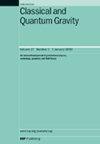PINCH: LIGO第三次观测运行中的管道噪声表征
IF 3.7
3区 物理与天体物理
Q2 ASTRONOMY & ASTROPHYSICS
引用次数: 0
摘要
本文提出了一种基于支持向量机(SVM)分类器对引力波探测器中由瞬态噪声(故障)引起的匹配滤波引力波搜索(管道)识别引力波候选触发器的方法。我们的方法包括训练SVM模型上的管道触发器,这些触发器发生在过量噪声周期之外,以区分由随机噪声引起的触发器和由故障引起的触发器。该方法独立应用于GstLAL搜索管道对激光干涉仪引力波天文台Hanford和Livingston天文台在O3观测运行的后半段产生的数据的触发。训练后的SVM模型为模糊触发器分配分数,量化它们与随机波动引起的触发器的相似性,分数高于定义阈值的触发器被归类为故障诱发。对这些触发器的分析揭示了不同故障类对搜索管道的不同影响,包括它们在相关参数空间中的分布。我们使用Bhattacharyya系数和过度代表性比率等指标来量化故障影响随时间和参数空间的一致性和普遍性。我们的研究结果表明,一些故障类型始终在参数空间的特定区域产生触发器,而其他类型则产生更广泛分布的触发器。我们观察到,在调试更改之前和之后的搜索管道中,散射光故障出现的方式不同,展示了这种检测器变化如何出现在管道对某些故障类的响应中。该方法为理解和减轻非高斯瞬态对引力波搜索管道的影响提供了一个框架,对提高探测灵敏度和更好地理解噪声种群具有重要意义。本文章由计算机程序翻译,如有差异,请以英文原文为准。
PINCH: pipeline-informed noise characterization in LIGO’s third observing run
We present a method to identify and categorize gravitational wave candidate triggers identified by matched filtering gravitational wave searches (pipelines) caused by transient noise (glitches) in gravitational wave detectors using support vector machine (SVM) classifiers. Our approach involves training SVM models on pipeline triggers which occur outside periods of excess noise to distinguish between triggers caused by random noise and those induced by glitches. This method is applied independently to the triggers produced by the GstLAL search pipeline on data from the laser interferometer gravitational-wave observatory Hanford and Livingston observatories during the second half of the O3 observing run. The trained SVM models assign scores to ambiguous triggers, quantifying their similarity to triggers caused by random fluctuations, with triggers with scores above a defined threshold being classified as glitch-induced. Analysis of these triggers reveals the distinct impact of different glitch classes on the search pipeline, including their distribution in relevant parameter spaces. We use metrics such as the Bhattacharyya coefficient and an over-representation ratio to quantify the consistency and prevalence of glitch impacts over time and across parameter spaces. Our findings indicate that some glitch types consistently produce triggers in specific regions of the parameter space, while others generate triggers that are more widely distributed. We observe that Scattered Light glitches appear differently in the search pipeline before and after a commissioning change, demonstrating how such detector changes appear in the pipeline’s response to certain glitch classes. This method provides a framework for understanding and mitigating the influence of non-Gaussian transients on gravitational wave search pipelines, with implications for improving detection sensitivity and better understanding noise populations.
求助全文
通过发布文献求助,成功后即可免费获取论文全文。
去求助
来源期刊

Classical and Quantum Gravity
物理-天文与天体物理
CiteScore
7.00
自引率
8.60%
发文量
301
审稿时长
2-4 weeks
期刊介绍:
Classical and Quantum Gravity is an established journal for physicists, mathematicians and cosmologists in the fields of gravitation and the theory of spacetime. The journal is now the acknowledged world leader in classical relativity and all areas of quantum gravity.
 求助内容:
求助内容: 应助结果提醒方式:
应助结果提醒方式:


